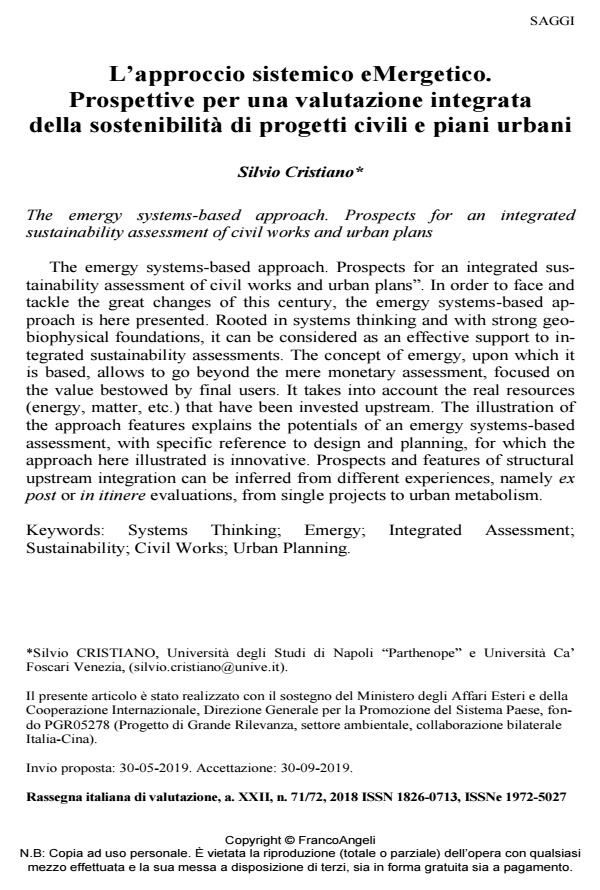The emergy systems-based approach. Prospects for an integrated sustainability assessment of civil works and urban plans
Journal title RIV Rassegna Italiana di Valutazione
Author/s Silvio Cristiano
Publishing Year 2019 Issue 2018/71-72
Language Italian Pages 24 P. 149-172 File size 791 KB
DOI 10.3280/RIV2018-071008
DOI is like a bar code for intellectual property: to have more infomation
click here
Below, you can see the article first page
If you want to buy this article in PDF format, you can do it, following the instructions to buy download credits

FrancoAngeli is member of Publishers International Linking Association, Inc (PILA), a not-for-profit association which run the CrossRef service enabling links to and from online scholarly content.
The emergy systems-based approach. Prospects for an integrated sustainability assessment of civil works and urban plans”. In order to face and tackle the great changes of this century, the emergy systems-based approach is here presented. Rooted in systems thinking and with strong geobiophysical foundations, it can be considered as an effective support to integrated sustainability assessments. The concept of emergy, upon which it is based, allows to go beyond the mere monetary assessment, focused on the value bestowed by final users. It takes into account the real resources (energy, matter, etc.) that have been invested upstream. The illustration of the approach features explains the potentials of an emergy systems-based assessment, with specific reference to design and planning, for which the approach here illustrated is innovative. Prospects and features of structural upstream integration can be inferred from different experiences, namely ex post or in itinere evaluations, from single projects to urban metabolism.
Keywords: Systems Thinking; Emergy; Integrated Assessment; Sustainability; Civil Works; Urban Planning.
- Impacts of COVID-19 Pandemic on the Global Flows of People and Goods: Implications on the Dynamics of Urban Systems Karim Gazzeh, Ismaila Rimi Abubakar, Emad Hammad, in Land /2022 pp.429
DOI: 10.3390/land11030429 - On the Systemic Features of Urban Systems. A Look at Material Flows and Cultural Dimensions to Address Post-Growth Resilience and Sustainability Silvio Cristiano, Amalia Zucaro, Gengyuan Liu, Sergo Ulgiati, Francesco Gonella, in Frontiers in Sustainable Cities 12/2020
DOI: 10.3389/frsc.2020.00012 - Re-Imagining Resilient Productive Landscapes Silvio Cristiano, pp.289 (ISBN:978-3-030-90444-9)
Silvio Cristiano, L’approccio sistemico eMergetico. Prospettive per una valutazione integrata della sostenibilità di progetti civili e piani urbani in "RIV Rassegna Italiana di Valutazione" 71-72/2018, pp 149-172, DOI: 10.3280/RIV2018-071008